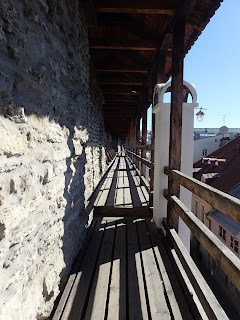116. Regional Travel #2.4 - Medieval fortifications in Tallinn
The medieval tower fortifications and city walls that circle Tallinn's Old Town date back to the 14th century. At its 16th-century peak, the 2.5 kilometer wall included 46 defensive towers. Only half of the towers are still standing, but most of the wall is still in place due to its 3-4 meter thick construction.
Some of the towers have colorful names: "Paks Margareeta" (Fat Margaret) and "Kiek in de Kök" (Peep into the Kitchen) are definitely my favorites. It's possible to climb some of the towers and explore a section of the wall, although we mostly just enjoyed the medieval ambience of strolling under, around, and through such picturesque surroundings. We did not walk the entire circumference of Old Town, so did not see every tower. We did pass by most of the highlights, though, especially on the north and east sides of the city.
St. Catherine's Passage is an atmospheric walkway that is perhaps the best place in Old Town to get the feeling that you're actually walking around during the medieval era. One side of the lane features the ruins of St. Catherine's Monastery and church. The monastery was destroyed in 1524 and never rebuilt. Marble slabs that were originally used as grave markers on the floor of the church have been installed vertically along the walls of the walkway, as a kind of open-air museum. The opposite side of the walkway is full of artists' studios and craft stores.
The Hellemann Tower was built in 1410. It was used at first for city defense, but in later centuries served as a prison, ammunition depot, and cafe. Now it's 100% dedicated to tourism. A section of the defensive platform atop the Town Wall - extending north and south away from the tower - is open to visitors following a renovation just over a decade ago. The pathway is quite high up but doesn't allow for sweeping views on either side of the wall, unlike the amazing views of Old Town to the west from the better-positioned tower viewing platform. On the other hand, a walk along the wall does give a strong feeling of having dropped into the 1500s or 1600s.
The Viru Gate on the east side of Old Town is marked by a pair of towers. The gate itself has long since been removed (circa 1880), but the towers and part of the bastion that remain here are a great signal that you are crossing over the threshold from modern Estonia into Tallinn's medieval past.
Some of the towers have colorful names: "Paks Margareeta" (Fat Margaret) and "Kiek in de Kök" (Peep into the Kitchen) are definitely my favorites. It's possible to climb some of the towers and explore a section of the wall, although we mostly just enjoyed the medieval ambience of strolling under, around, and through such picturesque surroundings. We did not walk the entire circumference of Old Town, so did not see every tower. We did pass by most of the highlights, though, especially on the north and east sides of the city.
St. Catherine's Passage is an atmospheric walkway that is perhaps the best place in Old Town to get the feeling that you're actually walking around during the medieval era. One side of the lane features the ruins of St. Catherine's Monastery and church. The monastery was destroyed in 1524 and never rebuilt. Marble slabs that were originally used as grave markers on the floor of the church have been installed vertically along the walls of the walkway, as a kind of open-air museum. The opposite side of the walkway is full of artists' studios and craft stores.
The Hellemann Tower was built in 1410. It was used at first for city defense, but in later centuries served as a prison, ammunition depot, and cafe. Now it's 100% dedicated to tourism. A section of the defensive platform atop the Town Wall - extending north and south away from the tower - is open to visitors following a renovation just over a decade ago. The pathway is quite high up but doesn't allow for sweeping views on either side of the wall, unlike the amazing views of Old Town to the west from the better-positioned tower viewing platform. On the other hand, a walk along the wall does give a strong feeling of having dropped into the 1500s or 1600s.
The Viru Gate on the east side of Old Town is marked by a pair of towers. The gate itself has long since been removed (circa 1880), but the towers and part of the bastion that remain here are a great signal that you are crossing over the threshold from modern Estonia into Tallinn's medieval past.
































Comments
Post a Comment